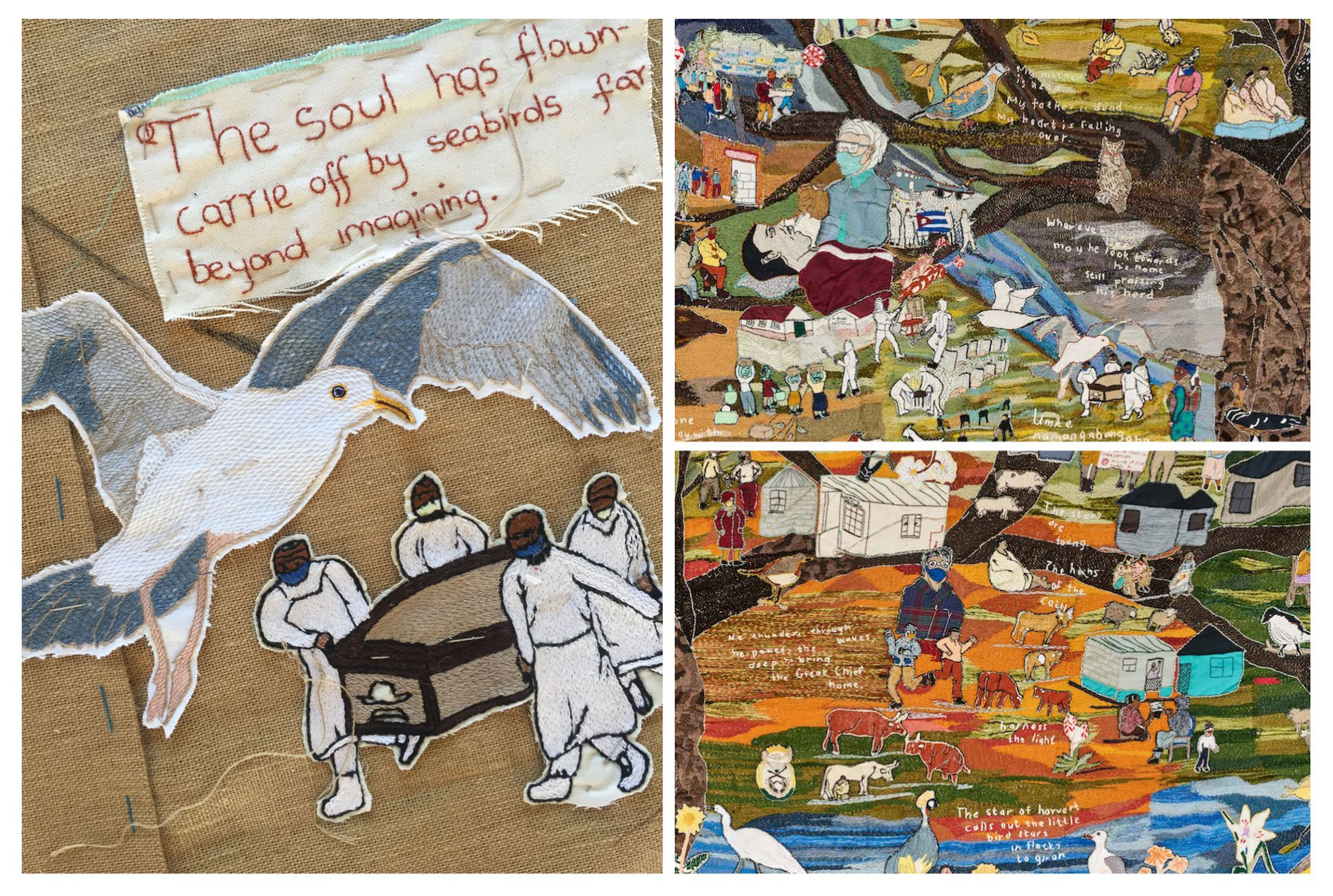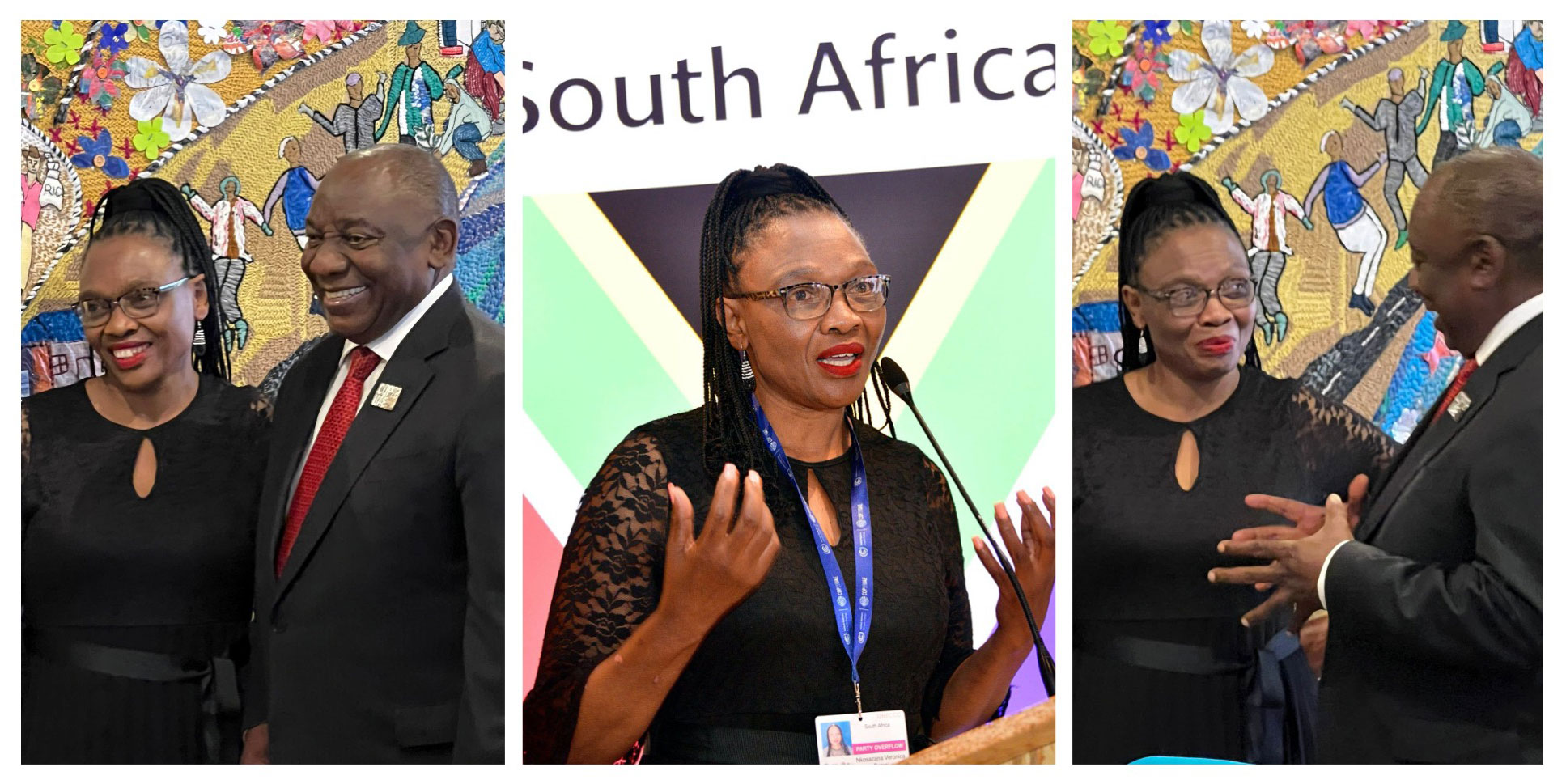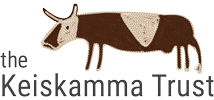Keiskamma Art Project in review: Reflections on four years since Covid
At the time of starting this newsletter, on 27 March 2024, we marked four years to the day since the start of lockdown in South Africa owing to Covid-19. Upon reflection, the pandemic brought uncertainty, but for the artists of Keiskamma Art Project (KAP), also an opportunity for the making of a special tapestry. We completed the Covid Resilience Tapestry in 2021 with independently raised funds, which we celebrate today with its sale and delivery to Australian philanthropist, businesswoman and art collector, Judith Nielson.
South African author, collaborator and friend, Marguerite Poland, wrote a beautiful prose piece for KAP at the time of the making of the Covid Resilience Tapestry. The artwork was made in response to having no income, nor knowledge of how long the pandemic would last, nor of its long-term impact. Marguerite’s writing is testament to her genius not only as a writer, but as a thinker and poet deeply embedded in the cosmology, language and environment of the Eastern Cape. She writes for KAP, “To imagine, to create, to record, especially in moments of uncertainty and fear, is an act of faith, not defeat”.
Marguerite Poland captures the starting conditions that have, over 23 years, described the premise for the making of so many of Keiskamma Art Project’s historic and iconic works. During the darkest months of 2020, Marguerite shared her poetry to help us find our theme for the tapestry and to reconnect artists with an age-old remembrance of resilience and of bearing seasons. Her haikus, from years of research in the Xhosa dominated areas of the Eastern, are about bird lore, cattle, nature and the seasons, some of which are highlighted in the Covid Resilience Tapestry.

The resilience Marguerite describes in her prose piece is moving and real. At the end of 2020, we had to relinquish administrative roles in art that could no longer be justified, hence cutting the team down to only producers of tangible value, in order to survive one more year. We were awarded vital funding from One Ocean Hub (UK) for a tapestry describing the spiritual, sacred connection between people and the ocean, that, alongside some support from the local National Arts Council, meant enough for a core team of artists and embroiderers for one year only. 2021 was a deciding one, and we were able to hold on, as well as direct our journey toward sustainability. Terminating contracts of permanent staff was an exceptionally difficult decision, yet resistance was not the response. On the contrary, the women who were affected expressed understanding; there are periods of plenty, and periods of struggle, but seasons also eventually turn.
Mongane Wally Serote wrote a poem for Don Mattera, a fellow poet who was banned between 1973 and 1982 by the apartheid government. The imagery is of nature, but of course the metaphors are deeply political. He writes:
it is a dry white season
dark leaves don’t last, their brief lives dry out
and with a broken heart they dive down gently
headed for the earth
not even bleeding.it is a dry white season brother,
only the trees know the pain as they still stand erect
dry like steel, their branches dry like wire,
indeed, it is a dry white season
but seasons come to pass.
Serote describes a time where being a human being with dignity and sovereignty, if you were black, was a near impossible feat. Marguerite reminds one of the accumulative tragedies experienced by the Xhosa people even before apartheid, to truly understand the Covid-19 moment within the context of the lives of rural people, where periods of hardship are written into both memory and history. There are new, but connected struggles today. At times a passive acceptance of fate arises – not fighting, not getting up – nor feeling the value in having a voice. And this is where art and the making of a tapestry is incredible in every respect.
Not only do we cohere across race, class, culture and geography in line with a shared vision, we connect, and even innovate, in order to bring a reality to life. I like to believe this comes with a strongly prophetic power, simply due to the power of imagination. In braving the imagining of an alternative present – as we did in the case of the Covid Resilience Tapestry – the groundwork, or rather stitch work, is lain, for these possibilities to come to fruition. We imagined a resilient future that is not premised on isolation, and that even in the remote village of Hamburg we can live productive, connected and progressive lives. We can mitigate against geographical distance through communication and so feel connected. Through reference and connection people in Hamburg and surrounding areas gain a sense of their place in the world. This lived experience of shared humanity speaks to the overarching motivation of Carol Hofmeyr, the founder of KAP and the Keiskamma Trust.
A noteworthy innovation during Covid-19 was introducing a data allowance for all artists and embroiderers before lockdown started, to make sure everyone could be reached on Whatsapp. Our ‘technological turn’ as an organisation was ultimately fuelled by Whatsapp! Then, it served more to share the right information about the disease, ward off fake news, connect people to good sources of information, etc. Today, it is used in every commission or collaboration to connect client or visiting artists with the team in Hamburg, to share process and images as references. Everything is stored, which is useful, in this digital communal archive.
Technology certainly can revolutionise a rural working environment, echoing an important development with regard to our iconic Umlibo tapestry, completed in 2023. Just over a year ago we commenced on an epic undertaking with WWF, the World Wide Fund for Nature, who were already working in the vicinity of Hamburg. Their restoration projects with fish, mussels and oysters, while working with coastal communities, were proving challenging. They were hoping for their message of climate change to sink in, and to find a project that could serve as a means for communicating this vital science. Their greatest struggle was how to advocate for marginal societies at a policy level and to reach those in power about the true effects of the climate crisis. It was the Covid Resilience Tapestry, lying flat on the ground, that Craig Smith, the Marine portfolio senior manager at WWF and driver of the making of Umlibo, first saw. He walked its 7,5 metre length excitedly, saying, “This is exactly what we are looking for!”
The Umlibo tapestry also works with scenarios, reimagining the current reality in terms of possible futures. WWF were ambitious in also wanting a documentary and original soundtrack – what they called a symphony – which in fact we managed, at least a soundtrack! All the parts came together beautifully and timeously in two local Hamburg launches of the artwork and one in Cape Town. The morning after the Cape Town launch we took down the tapestry and packed it into a travel suitcase that went with Naledi from WWF that very afternoon to Dubai, just in time for the COP28 climate summit.
Watch the Umlibo documentary here
Watch a short film of the Hamburg launches here
A week later, Veronica Betani flew to COP28 to represent us at the South African pavilion, where Umlibo took centre stage. No one realised that Veronica would have to entertain delegates, diplomats, and heads of state from around the world every day for over a week. Vero sent a photo of herself one evening with a cold beer. Even though it cost the equivalent of R400, she needed it, she explained. For Vero, mother of three children who are mostly absent and bringing up six grandchildren alone, it is a lot of money to spend on a beer. But we were behind her in every respect, and endorsed her need to stay cool and resourced! She was doing extraordinary work. In fact, Veronica blew us all away.
On a hot Friday afternoon in bustling Gqeberha, pictures arrived via Whatsapp of Veronica looking stunning next to our nation’s president with our Umlibo climate change advocacy tapestry behind her. Then came the videos, of the president’s passionate response to Umlibo and the address that Veronica gave. Soon the president used his experience of Umlibo and meeting Veronica from Keiskamma Art Project as the start of his official presidential communication, introducing his plans for a just energy transition. We had met the biggest challenge set by WWF, namely, to reach those with real power, and for them to understand the impact of climate change on marginalised communities.
As per the president’s official communication:
“Dear Fellow South Africans,
We have just returned from the United Nations Climate Change Conference in Dubai, known as COP28, where important decisions taken so far will affect the future of our planet.
The discussions at COP28 have significant implications for our country and people. The impact of climate change is a measurable reality in South Africa, with poor, rural communities in particular bearing the brunt.
While in Dubai, I visited the South Africa pavilion, where I was shown a striking artwork called the Umlibo tapestry. It was made by a group of rural women from Hamburg in the Eastern Cape. Woven in the tapestry are images that tell a story of the impact of climate change on rural coastal communities in the province struggling with extreme weather patterns, declining fish stocks and constrained livelihoods.
The Umlibo tapestry communicates the urgent and personal impact of climate change on one particular community. There are hundreds, thousands and millions more communities, in South Africa, on the African continent and across the Global South who are being negatively affected by climate-change induced extreme weather.
A central part of South Africa’s response to this crisis is the Just Energy Transition (JET) Investment Plan 2023-2027, which outlines the actions we need to take and the investments that we need to make to meet our climate targets.“
Cyril Ramaphosa then asked Veronica, “If we could do one thing for a community like yours, what would it be?” Echoing what we first imagined during Covid-19, that technology might help us in our global footprint and to mitigate against isolation, Veronica answered, “The internet. Build us towers, so that we can have reception, so our people can all have network.”

Today a large part of my own role in leadership is hearing what each of our artists and embroiderers need, and working to create the architecture in which they can achieve their own dreams. This is exceptionally challenging as one is up against complex systems – governmental, economic, historical, cultural, organisational, each with their own entanglements, inherent fears and challenges – so the wheels turns slowly. Our focus since 2020 has nevertheless been on our beneficiary community, driven by an indicator of change described simply by how much an embroiderer is earning per month, and how many embroiderers are working. In 2020 the average income of an embroiderer was R500 per month. In the closing months of 2023, that average had shifted to R5000 per month, a tenfold increase.
With a model of sustainability becoming a reality, we are starting to connect, communicate and invest in new networks which is heartening. Our founder’s ethos has always been openness; to mistakes, to learning, to growth, and to ensure that people come first. The integrity of our process we define in terms of our theory of change, which is, quite simply, a description of how we create change in the lives of our beneficiaries. In the making of an iconic work, especially, this process includes: 1. Education, 2. Community engagement, 3. An open and collaborative production process, 4. Remuneration, and at the end of last year we added 5. Advocacy. Veronica affirmed this vital component. For Veronica to be able to clearly think through the one thing that would enable not only herself, but her entire community, is testament to the fact that as someone grows in their own agency, ‘freedoms’ and confidence – hence, not only economically – so they enable others, which is how ubuntu should work.
It feels good to think there was power in Cebo Mvubu’s idea of stitching the portrait of Cyril Ramaphosa at the start of the Covid Resilience Tapestry next to the young Xhosa prophetess, Nonqawuse. Cebo likened the president to the prophetess of the 1850s whose vision led to the decimation of the Xhosa people’s cattle, in the hope that this act would drive the white men away, and the wealth of their nation would be restored. Four years later, through Umlibo, Veronica is influencing our country’s president’s vision and thinking.

We will see if Umlibo reaches the Union Buildings as the president suggested. In the meantime, Marguerite is correct in so eloquently contextualising an ethos of resilience, and that this did not begin in 2020 with Covid-19. This is a drive built into the culture of survival, of interdependent lives lived close to nature and close to each other. With the possibilities for expression that is transformative through art, this is a drive that will not desist.
In closing, it has been a privilege to work with KAP for just over four years, in which time I have met and worked with people within Hamburg and from around the world who are committed to mutuality, reciprocity, and to what is humanising and good. A significant legacy has been created in Hamburg through the work of Carol Hofmeyr with the support of her husband, Justus Hofmeyr. Our current reality, building on this legacy, is non-hierarchical and sustained through integrated efforts by many networks, including artists and embroiderers of long service led today by Cebo Mvubu and the Trust team under the leadership of Zuko Gabela. I am at best a facilitator and engine cleaner.
It is encouraging to look ahead to so many inherent possibilities in the work we do in this microcosm of South Africa. This year we look forward to the renovations of our studios and a refurbished gallery, as well as a stronger ecology of communication that includes a new website. And of course, some extraordinary large scale tapestries! Acknowledgement is owed to our primary funder and support, the Lemonaid and Charitea Foundation led by Aileen Puhlmann. Their financial support, as well as commitment to motivation, partnership and accountability, has been key to the growth we have experienced. They have been our primary enabler, with the integrity of their reporting and evaluation measures forcing commitment to change and the imagination required to achieve it
Our additional deepest gratitude is further owed to Bruce Howard in strategic development, Dorothea Moors at GFI (supported by Rose von Wildemann and Anna Stewart) in their unwavering support and commitment to the arts, along with Mirna Wessels and Tamlin Blake from the Spier Arts Trust. Janetje van der Merve and Sally Currin, exceptional strong women in the creative developmental landscape from Mapula have become solid friends. To Johnny Goldberg in strategic business development and Pippa Hetherington for blazing a passionate trail for KAP in so many ways, supported by Cathy Stanley. To Tracy Lynch from Clout SA as well as Nicola Ashmore from Brighton University for working with us toward strong and exceptional visions. To Andy Hofmeyr, Carol and Justus Hofmeyr and the Keiskamma Trust team for their gracious support. In the background is the support and commitment of countless more, hopefully touched on in some of our project highlights.

